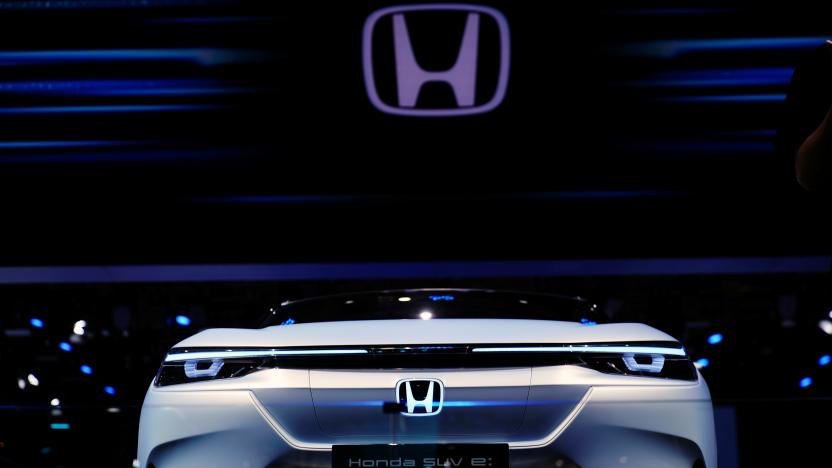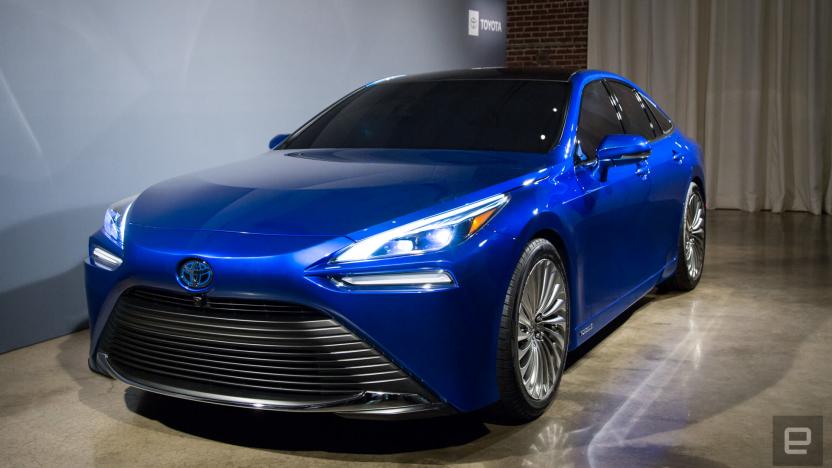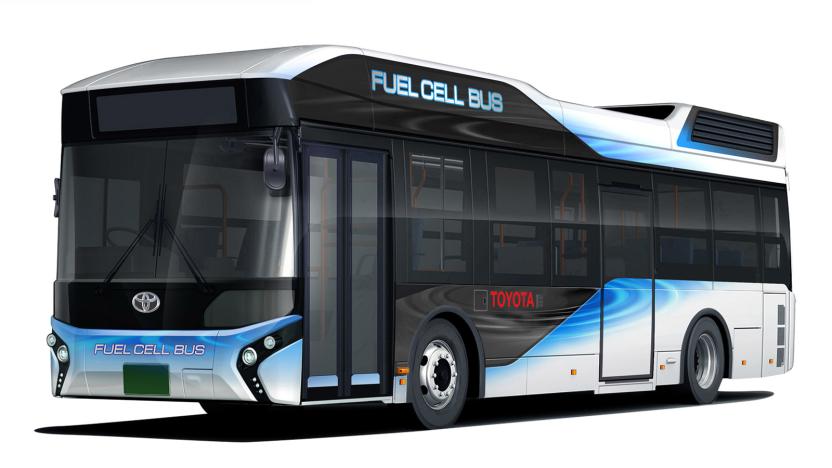fcv
Latest

Honda aims to shift car sales entirely to EVs by 2040
The automaker also revealed plans for an EV platform called e:Architecture.

Toyota’s hydrogen fuel-cell Mirai gets a new, luxurious look
Hydrogen fuel-cell vehicles have a tough time out there in the real world. They have all the ecological advantages of an EV and the refueling speed of a gasoline vehicle. But there's that whole infrastructure issue. Without places to refuel, the best car in the world is essentially worthless. But that hasn't stopped Toyota from introducing a new, classier Mirai ahead of the Tokyo Motor Show.

Honda's next-gen Clarity hydrogen cars land in California
Honda has delivered the first hydrogen-powered Clarity fuel cell vehicles (FCVs) to dealers in Torrance, California, home of the automaker's US campus. Approved buyers can take one home on a lease for $2,868 down and $369 a month for three years, a price that includes 20,000 miles per year and up to $15,0000 of hydrogen fuel.

Toyota could abandon hydrogen in favor of EVs
Toyota has been vocal in its belief that hydrogen-powered vehicles like the Mirai will eventually replace gas and diesels. But this insistence makes the company's recent decision to launch a long-range EV similar to the Tesla such a surprise. Reuters (via Nikkei) is reporting that the carmaker will quietly reverse its longstanding resistance to pure all-electric vehicles in the very near future. It's believed that Toyota will launch a new EV with a range of around 186 miles on a charge by 2020 as it looks to make all of its products emissions-free by 2050.

Toyota's hydrogen buses can work as emergency generators
Toyota will start selling fuel cell (FC) buses in 2017, with the aim of selling up to 100 in the Tokyo area ahead of the 2020 Olympic games. The company is using a beefed up version of the fuel system it developed for the Toyota Murai, with 10 high pressure tanks holding 600 liters of highly compressed H2. That gives it 235 kWh or power, about three times that of a Tesla Model S, meaning it "can be used as a power source in the event of disasters," the company said in a press release.

Toyota's car of the future drives like a Camry
The Toyota Mirai looks like it's ready to swallow you whole. From the front, the hydrogen fuel-cell car has the aggressive stance of a bulldog. But as you circle the vehicle, the styling quickly softens to clean lines that lead to a rear end that would blend in among a sea of cars trapped in traffic. It's the future of driving (one version of it, anyway), but as I found after a recent test drive, it's also ready to hit the freeway without much fanfare.

Honda's hydrogen-powered Clarity goes on sale in Japan
Hydrogen-powered cars are less efficient and environmentally friendly than EVs, but nobody can deny that they're more practical. Case in point is Honda's Clarity fuel-cell vehicle (FCV), which is now on sale to select buyers in Japan. Unlike EVs, which can go a maximum of around 270 miles (in the case of Tesla's Model S), the Clarity can run 750km (466 miles) on a tank of 70MPa compressed hydrogen. That's assuming you can find a hydrogen filling station -- there are only around 15 or so in the nation at the moment. Performance-wise, the 174-horsepower motor delivers a top speed of around 100 mph.

Toyota's concept car duo couldn't be more different
One car; fashioned from chrome alloy, exposed suspension and steampunk dreams. Another? See-thru turquoise-hued glass, white spiderweb frameworks, and a hydrogen-powered heart. Toyota's concept cars take very different creative routes with the humble automobile. The more rustic "Kikai" is an attempt to draw out the literal inner beauty of cars, showcasing mechanical parts that aren't usually seen. Tires and suspension take pride of place, while a tiny window in the floor the carriage lets passengers see what's going on underneath the car. Then there's the FCV Plus...

Toyota's hydrogen concept car could power your concept home
While we're stuck working out the mpg of a practical family sedan, Toyota's off playing with our dreams (or nightmares) with cars like the above. The latest round of concepts from the Japanese auto-maker are being shown at the Tokyo Motor Show, and include a diminutive, sporty-looking Scion S-FR (reverse-world FR-S?), the hot rod-esque Kikai and the hyper-futuristic FCV Plus (pictured).

BMW's autonomous i3 learned how to park and forgot how to crash
BMW is at CES this week demonstrating some of its newest advances in the field of highly autonomous driving. If you remember, last year we were taken to the Las Vegas Motor Speedway and sped around the track in a tricked-out driverless 4 Series. This year's theme remains essentially the same, though rather than focusing on high-speed driving and drifting, the German automaker has slowed everything down. We were invited to a hotel's rooftop parking area where a couple BMW i3s were parked at either end of the space. One would demonstrate 360-degree collision avoidance and the other fully automated parking. They both did a very impressive job.

Toyota shares its fuel cell patents to help its hydrogen dreams come true
Toyota's apparently hedging it's bet in the hybrid world by also gambling on a hydrogen-powered future. In an apparent attempt to drum up some development support, all 5,680 or so of Toyota's FCV (Fuel Cell Vehicle) patents developed for and in support of the Mirai are being tossed out to the world for use royalty-free. Included are some 1,970 patents related to fuel cell stacks, 290 to high-pressure hydrogen tanks, 3,350 involving the software to manage the system and a further 70 for production and supply. The fuel cell patents around the actual cars will remain royalty-free until 2020, while the others around production and supply will stay royalty-free for an unlimited time.

Toyota reportedly working on a hydrogen-fueled Lexus limo
Toyota's first hydrogen car hasn't even gone on sale yet here in the US, and already we're hearing rumors about a follow-up vehicle. According to the Australian website Motoring, the Japanese auto giant is planning on taking the same fuel cell system it used in its mid-range Mirai sedan, and putting it into a higher-end Lexus LS limousine. For the most part, then, the new vehicle will make use of the same technology, though Toyota will apparently have to do some retro-fitting in order to make it work inside the current Lexus LS. (Unlike the LS, the Mirai was built from scratch as a hydrogen car.) If Motoring's report is correct, the new Lexus will have a fuel cell under the front seat, with the hydrogen tanks located behind the rear seat. Also, despite the fact that the LS wasn't originally designed as a hydrogen vehicle, it will reportedly offer nearly the same range as Toyota's existing FCEV: 239 miles, versus 300 on the Mirai. No word yet on price or whether this report is even true. And we suspect it could be a while before anyone sets the record straight -- the hydrogen-fueled Lexus LS is rumored to launch "by 2017," up to two years from now.

What you need to know about hydrogen fuel cell vehicles
Damn the torpedoes (and Teslas)! Two of Japan's biggest automakers are about to make sizable wagers on a different kind of clean fuel tech: hydrogen power. Toyota will launch the $57,500 Mirai fuel cell vehicle (FCV, above) next year, while hydrogen veteran Honda will out a model in 2016. But wait, aren't EVs the last word in green cars? Fuel cell cars are EVs, in a way, but you can fill one up with hydrogen in five minutes rather than waiting hours for a charge. The only way to do that in an electric vehicle (EV) is by swapping the entire battery. So why is there exactly one production FCV available to buy today, but EVs everywhere? That's a tale of efficiency, fuel, pollution and politics.

Toyota's hydrogen car gets a name and more US filling stations (update: and price)
Toyota has announced that its upcoming fuel cell vehicle (FCV) will be called the Mirai and that it's building a network of hydrogen stations in the US Northeast to support it. The $69,000 (update: maybe as cheap as $45,000 -- check after the break)vehicle is due to arrive in the US in 2016. The Japanese automaker proclaimed that "the future has arrived," (Mirai means "future" in Japanese) which may make the thousands of people who've owned a Honda FCX Clarity FCV since 2005 gag. But despite being late to the game, Toyota is now making a huge bet on FCVs. It has teamed with Air Liquide to build 12 hydrogen stations in New York, New Jersey, Massachusetts, Connecticut, and Rhode Island. The stations will be "strategically placed" so that drivers of the 300-mile-range Mirai can tool around the region without (much) anxiety. Previously, Toyota said that 19 hydrogen stations would be installed in California.

Toyota is taking fuel cells seriously, unveils concept car and reaffirms launch in 2015
Fuel cells are very much back on the energy agenda. It's not smartphones this time, however, but vehicles. From Toyota, no less. The company's fuel cell program is about to bear fruit and it's revealed a sleek, shiny concept design that's promising a range of "at least" 500 km and a refuel time comparable to good ol' gasoline vehicles.The eventual production model car is planned to go on sale in 2015, which would ensure Toyota keeps the promise it made way back in 2010. The blue color scheme and softened design curves are meant to evoke the "key characteristics" of fuel cell cars: turning air into water. There's even a wave motif fuel cap -- it's all about the details. Once filled and plugged into a compatible home, the FCV is also apparently capable of providing enough electricity to power an average Japanese home for over a week (10 kWh). To accomplish this, two high-pressure hydrogen tanks are stored along the undercarriage, but if you're depending on the FCV to function as, well... a car, then you'll be happy to hear that it can carry around three passengers, alongside the early-adopting driver.

Fuel cells get stronger, potentially cheaper with graphene, ITO
As the sustainable Juggernaut of fuel cell vehicles (FCV) powers ever forward, a group of scientists are cooking up ways to make the alternative energy source more durable and even cheaper. By combining graphene -- think pencil lead -- and indium tin oxide (ITO) nanoparticles, the team produced a catalytic material that is both stronger and more chemically active than the usual catalytic combo. Fuel cells typically use a chemical catalyst like platinum, sitting atop a base of black carbon or metal oxides, to break down oxygen and hydrogen gases, creating water in the process -- thing is, carbon is easily eroded by the resulting water, and metal oxides, while more stable, are less conductive. Using graphene -- which because of its porousness erodes less quickly -- in combination with the stable ITO and platinum nanoparticles, researchers have created what could be referred to as a super fuel cell -- a stronger, longer lasting, and potentially cheaper version of the alternative energy source. Unfortunately, without enough hydrogen filling stations, these super fuel cells won't come to anyone's rescue anytime soon.

13 Japanese companies join to further fuel cell adoption, also plan to ride bikes together
What's going to spin the tires in your car of the future? Will it even have tires? Right now it looks like either hydrogen fuel cells or pure EVs will be dominating the streets in a few decades, and thankfully they share enough technology for us to think they can peacefully co-exist -- just like Apple and Microsoft fanboys and girls have been known to host really great parties together where they engage in long, respectful discussions regarding their differing opinions. However, while EVs are already well on their way, for fuel cells to take off we're going to need more hydrogen filling stations and more cooperation between auto manufacturers. That's happening now in Japan, with 13 companies -- Toyota, Nissan, and Honda along with a number of gas and utilities companies -- joining forces to enable a "smooth domestic launch" of fuel cell vehicles as soon as 2015. They hope to create about 100 hydrogen stations across the country, work to form a broader hydrogen supply network, and also educate people about FCVs in general. We'll give them a head start by letting you know that stands for "Fuel Cell Vehicle," though they're also often called FCEVs, or "Fuel Cell Electric Vehicles." Bam! Two items off the to-do list.









